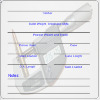One more field to consider: Date.
I bought 5,000 labels at Staples decades ago (they still stick) and when I get ready to load a batch of cartridges, I will pre-print labels with the data shown below and stick one on the outside of every box.
Cartridge type
Date loaded
Primer maker and type
Powder type and weight
Bullet maker, weight and configuration
Along with space for a handwritten number to identify the box.
The handwritten number ties to the checklist I complete when reloading that has my reloading procedures as well as space for range conditions, chronograph reading and comments. The checklist is kept in a binder in the cabinet above my reloading bench so I can quickly associate any cartridge with a record of the components and the process used to make it.
I had not been recording OAL because once I got the bullet seater plugs dialed in, my rifles would happily feed the .30 Carbine, .223 and 5.7 mm Johnson rounds I made. Now that I'm moving into 9 mm Parabellum, I can see I will need to add a field for that.
I bought 5,000 labels at Staples decades ago (they still stick) and when I get ready to load a batch of cartridges, I will pre-print labels with the data shown below and stick one on the outside of every box.
Cartridge type
Date loaded
Primer maker and type
Powder type and weight
Bullet maker, weight and configuration
Along with space for a handwritten number to identify the box.
The handwritten number ties to the checklist I complete when reloading that has my reloading procedures as well as space for range conditions, chronograph reading and comments. The checklist is kept in a binder in the cabinet above my reloading bench so I can quickly associate any cartridge with a record of the components and the process used to make it.
I had not been recording OAL because once I got the bullet seater plugs dialed in, my rifles would happily feed the .30 Carbine, .223 and 5.7 mm Johnson rounds I made. Now that I'm moving into 9 mm Parabellum, I can see I will need to add a field for that.


